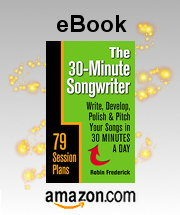Read the 30-Minute Songwriting Session technique I showed you in the previous post to get familiar with this quick, effective approach to writing songs.
Set your timer for 30 minutes, and then follow these ideas for a series of writing workouts that will get your next song started and well on its way to being finished.
◆ Develop a title into a lyric idea (30 min.)
Choose a title or lyric line you want to use. Start a lyric by letting it suggest a few questions you can answer. Questions like:
What does the title or lyric line mean?
What happened that made the singer feel this way?
How does the singer feel about it?
Why is this important to the singer?
What can the singer do about it?
What does the singer need to say about it?
Write your answers down in phrases. (These can be turned into lyric lines more easily than full sentences.) Grab the lines you like best and string them together. If you like what you get, keep it with your title and file it away to work on in a future session.
◆ Get into the groove (30 min.)
All of today’s successful songs feature a steady rhythm groove. Get familiar with a new one or rediscover an old favorite in 30 minutes.
If you play guitar, check out strumming grooves in songs like “Riptide” (Vance Joy) or “Most People Are Good” (Luke Bryan). Piano players, take a listen to “All Of Me” (John Legend) or “Brave” (Sara Bareilles). Or try one of the chill electronic grooves in songs by Billie Eilish or the Indie Folk rhythms of Gregory Alan Isakov (very popular in Film & TV). Play the groove until it feels comfortable. Record a couple minutes of the groove.
TIP: Once every couple of weeks, spend a session looking for and learning new rhythm grooves. If you don’t play guitar or keyboard, try some of the suggestions in my blog post Write a Song If You Don’t Play an Instrument. Take 30 minutes to try each of the ideas. Find one or more that work for you and devote more 30-minute songwriting sessions to it.
◆ Write a melody to a rhythm track (30 min.)
Using the groove you created in the previous session (or a karaoke track or beat) add a few melody lines to it. Sing nonsense syllables or placeholder lyrics so you can focus on the melody only.
- Start with a single melody line and repeat it a few times.
- Then sing it again while changing the note pitches.
- Play with different note pitches. When you find something you like keep it and repeat it.
Sing a new line that might follow those two repeated lines.
- Sing it again but replace one note with silence.
- If you have a long line, split it in half and repeat the first half.
- Split a long note into short notes.
- String short notes into one long note.
When you find something you like keep it and repeat it.
Keep playing with your melody line, changing note pitches, note rhythms, and phrase lengths. If you like any part of it, record it. Come back to it in another session and add chords. Then develop it into a verse or chorus melody.
This is a great exercise for warming up before or during a melody writing session. If you get stuck on a melody, try any of the techniques described here.
◆ Explore hit chord progressions (30 min.)
Choose one of the grooves you found in the previous session and add a chord progression. Many hit songs use generic four-chord progressions that can’t be copyrighted, like these.
| Am | F | C | G | or…
| C | G | Am | F | or…
| G | C | D | Em |
Once a month, spend one of your 30-minute sessions looking at the chord progressions of hit songs that you like. When you find a common, repetitive three- or four-chord progression like one of these, make a note of it so you can use it in a song of your own.
You’ll find more lyric, melody, and chord Song Starters on this page.
◆ Create a track to write to (30 min.)
Choose a rhythm groove and play one of the chord progressions listed in the previous session or one of your own. Give it a mood or attitude. Is it bluesy or lullaby-like? Angry or blissful or sad? What’s the style: intimate Singer-songwriter or powerhouse Rock? Play softly or attack it with strength? Slow and loose or aggressive and tight? It’s up to you.
Make a few notes on what you have in mind for the track vibe. Save your notes along with any melody or lyric phrases that come along with it. Make a rough recording of your rhythm and chords. Aim for 2 minutes in length. Then walk away at the end of 30 minutes.
◆ Write a lyric to a track (30 min.)
Using the track you created in the previous 30 minute songwriting session (or a karaoke track or beat), begin to put a lyric together. How do the rhythm and chords make you feel? Happy? Sad? Ready for a party? Heartbroken? Yearning? Angry? What kind of situation or relationship does the track suggest? What kind of person would sing a song to this track and what would they say? Let the track suggest feelings, images, character, actions, and ideas.
The music track is like underscore for your lyric. Music and lyrics should support each other, creating a single emotional feel. This is a good way to make sure that happens.
Write down any lyric phrases and ideas that occur to you as you listen to or play the track. Does the rhythm of the track suggest any melody ideas? Record the melody with your rough lyric and keep it to work on in another session.
Keep your song moving forward. Read Part 3 of the 30-Minute Songwriting Session series to find out how to solve a problem if you get stuck.


